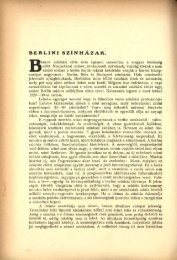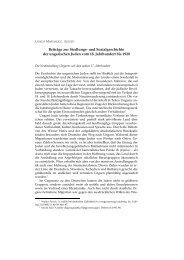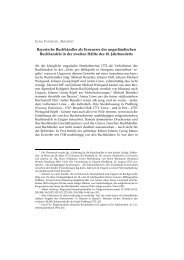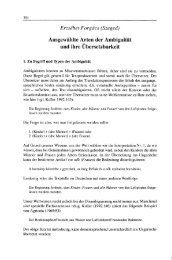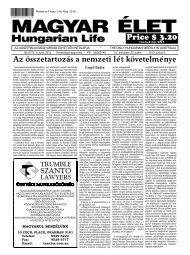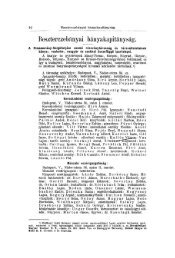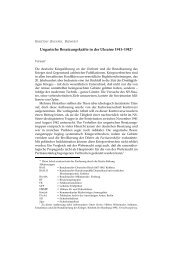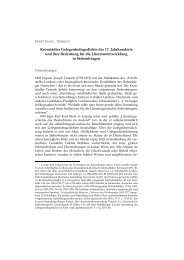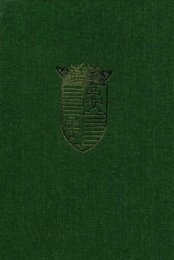Journal of Eurasian Studies - EPA
Journal of Eurasian Studies - EPA
Journal of Eurasian Studies - EPA
Create successful ePaper yourself
Turn your PDF publications into a flip-book with our unique Google optimized e-Paper software.
April‐June 2010 JOURNAL OF EURASIAN STUDIES Volume II., Issue 2.<br />
_____________________________________________________________________________________<br />
HORVÁTH, Izabella<br />
The Tarim Basin Mummies: a Commentary<br />
Since the mid‐nineteenth century much <strong>of</strong> Western historical research has been motivated by the desire<br />
to prove that Indo‐Europeans were responsible for significant cultural development and evolution in<br />
Europe and beyond. Over the years major inventions, such as the chariot, bronze working, and horse<br />
riding have all been claimed as Indo‐European creations. These speculations are based largely on the<br />
assumption <strong>of</strong> cultural diffusion from a single source, that is Europe, and <strong>of</strong>ten overlook the possibility <strong>of</strong><br />
independent clusters <strong>of</strong> cultural development taking place in tandem in different parts <strong>of</strong> the world.<br />
Moreover, the research <strong>of</strong>ten lacks a global perspective and neglects to include pertinent historical data<br />
from farther afield.<br />
While early efforts to prove Indo‐European cultural primacy nearly 150 years ago may be<br />
understandable, if not excusable, it is hardly so in the 21 st century. This is especially true in regards to the<br />
study <strong>of</strong> the early history <strong>of</strong> China and the question <strong>of</strong> western influence. More <strong>of</strong>ten than not western<br />
researchers ignore pertinent Chinese historical records as well as Chinese and Russian scholarly work in<br />
order to maintain claims <strong>of</strong> Indo‐European cultural primacy. This predisposition <strong>of</strong> viewing cultural<br />
diffusion as moving exclusively from West to East complicates and confounds the relevant questions and<br />
issues we are faced with when researching the cultural history <strong>of</strong> ancient China.<br />
One <strong>of</strong> the most famous and prevalent cases in which the inclination <strong>of</strong> western scholars to seek<br />
cultural influences moving from the Indo‐European west to the Chinese east, is in the case <strong>of</strong> the Tarim<br />
Mummies. Scholars such as Sir Aurel Stein, Albert von le Coq, and Sven Hedin came across these<br />
fascinating finds, excavated in Xinjiang, China in the early 20 th century and dating between 1800 BCE and<br />
200 CE. More recently, they have been dealt with by western scholar Victor Mair.<br />
Mair, a Chinese language pr<strong>of</strong>essor at the University <strong>of</strong> Pennsylvania, visited Xinjiang in 1994 and<br />
reported his “discovery” in the Urumqi Museum <strong>of</strong> a number <strong>of</strong> mummified remains which looked to<br />
him to be European (Hadingham, 1994). The report about “Mysterious Blonde Ancient Europeans in<br />
China” spread like wildfire to sensation‐seeking media. Simply entering “Tarim Mummies” into a Google<br />
search verifies the report’s far‐reaching effects.<br />
The journalist, Hadingham reported in Discover magazine that some <strong>of</strong> the mummies were blonde and<br />
that according to Mair, were <strong>of</strong> Celtic stock who rode chariots across Central Asia introducing this<br />
technology to China, along with the knowledge <strong>of</strong> surgery, bronze working and textile weaving. Early<br />
Chinese historical records do not mention the origins <strong>of</strong> bronze working, and the use <strong>of</strong> the chariot, thus<br />
leaving western scholars to continue their guesswork about the diffusion <strong>of</strong> these inventions. However,<br />
speculations on the subject do not bring us any closer to answering these questions.<br />
My own research pertaining to the Tarim mummies began in January 1995 when I had the opportunity<br />
to personally conduct fieldwork in Xinjiang. This naturally included seeing the mummies in the Urumqi<br />
_____________________________________________________________________________________<br />
© Copyright Mikes International 2001‐2010 74


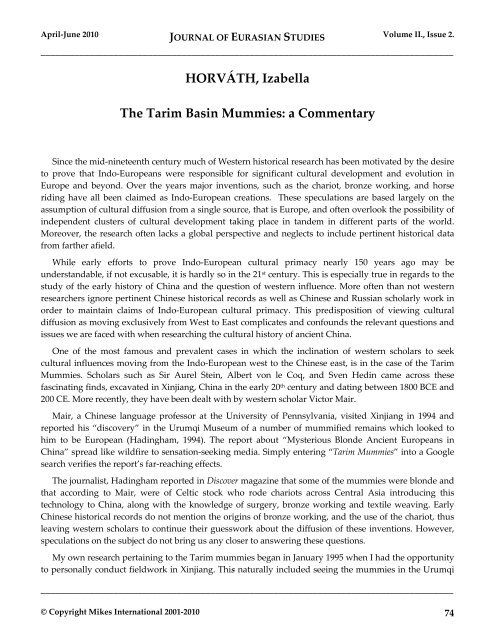
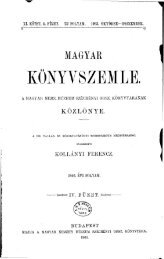
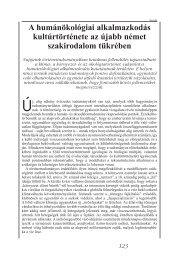
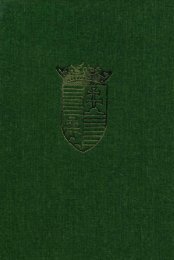
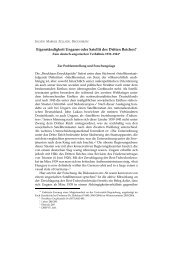
![Letöltés egy fájlban [36.8 MB - PDF] - EPA](https://img.yumpu.com/23369116/1/172x260/letoltes-egy-fajlban-368-mb-pdf-epa.jpg?quality=85)
